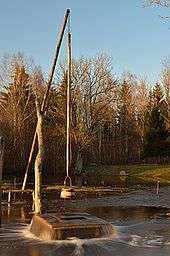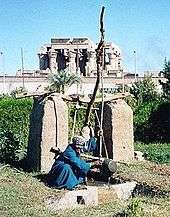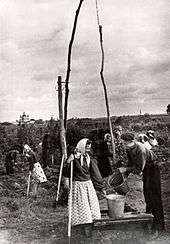Shadoof
A shadoof or shaduf[1] (an Arabic word, شادوف, šādūf) is an irrigation tool. A less common English translation is swape[2] and it is also called a counterpoise lift,[3] well pole, well sweep. or simply a sweep in the US.[4] The shadoof was an early tool used in irrigation by the ancient Egyptians who lived along the Nile River and the Mesopotamians. Irrigation is a way of watering crops using basins, dikes, ditches, walls, canals, and waterways. The shadoof was used to lift water from a river or lake onto land or into another river or lake. It looks like a long pole with a bucket attached to the end of it. [5] It is still used in many areas of Africa and Asia and very common in rural areas of India such as in the Bhojpuri belt of the Ganges plain where it is named "dhenki". They remain common in Hungary's Great Plain, where they are known as "gémeskút" (literally, "heron wells") and are considered a symbol of the region.[6] It was also known by the Ancient Greek name kēlōn (κήλων) or kēlōneion (κηλώνειον)
Construction
The shadoof consists of an upright frame on which is suspended a long pole or branch, at a distance of about one-fifth of its length from one end. At the long end of this pole hangs a bucket, skin bag, or bitumen-coated reed basket. The bucket can be made in many different styles, sometimes having an uneven base or a part at the top of the skin that can be untied. This allows the water to be immediately distributed rather than manually emptied. The short end carries a weight (clay, stone, or similar) which serves as the counterpoise of a lever. When correctly balanced, the counterweight will support a half-filled bucket, so some effort is used to pull an empty bucket down to the water, but only the same effort is needed to lift a full bucket.
With an almost effortless swinging and lifting motion, the waterproof vessel is used to scoop up and carry water from a body of water (typically, a river or pond) onto land or to another body of water. At the end of each movement, the water is emptied out into runnels that convey the water along irrigation ditches in the required direction.
References
- ↑ "ASABE technical paper describing alternative names". Asae.frymulti.com. Retrieved 2012-04-03.
- ↑ "Definition of "Swape"". Webster's Revised Unabridged Dictionary. MICRA Inc. Retrieved 2007-04-25.
- ↑ D. T. Potts (2012). A Companion to the Archaeology of the Ancient Near East. John Wiley & Sons. p. 264.
- ↑ Knight, Edward Henry. Knight's American mechanical dictionary. Vol. 3. New York, Hurd and Houghton: Riverside Press, 1877. 2,468. Print.
- ↑ John Roberts (historian), edited by Allen Lane (2013). The Penguin History of the World. Penguin Books.
- ↑ Hortobágy National Park
External links
| Wikimedia Commons has media related to Shadoofs. |


